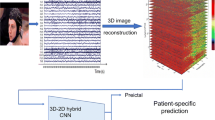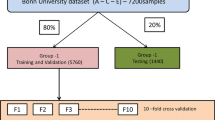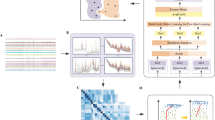Abstract
The nonlinear dynamical systems can be stabilized on attractors in chaotic states, where the attractors depicted by dynamical trajectories may take on specific geometries. Electroencephalogram (EEG) signals are typically chaotic signals that have various nonlinear dynamic characteristics. Intrinsic geometry of EEG signals could contribute to tracking the recurrence of seizures and probing epileptic disorders, but it is ignored in most deep network-based seizure detection algorithms. Therefore, this paper presents an automatic detection framework called Recursive State-Space Neural Network (RSSNN) to infer the EEG geometry from single-channel signals and identify different epileptic patterns with a fast computational speed. RSSNN consists of a mathematical mapping module and a deep learning model. The former reconstructs EEG geometry in a high-dimensional state-space and maps it to a two-dimensional graph. The latter is a newly designed lightweight (0.68 MB) fully convolutional network that decodes geometry into brain states. We validated RSSNN on a public EEG dataset collected from epileptic patients with seizure and seizure-free conditions and healthy volunteers. A sliding window with a one-second length is utilized to verify the performance of RSSNN at the segment level. Moreover, the voting strategy is adopted to obtain the final prediction at the subject level. In the testing phase, RSSNN obtains an overall 99.79% accuracy at the EEG segment level and reaches 100% accuracy at the subject level. Notably, it takes less than 25 ms to predict one subject. This study proves the potential of EEG's intrinsic geometry as a seizure indicator for real-time monitoring by combining it with a lightweight neural network. It enriches the deep learning-based seizure prediction methodology in nonlinear dynamics.









Similar content being viewed by others
Data availability
The datasets generated during and analyzed during the current study are available in the "Klinik fűr Epileptologie, Universität Bonn" repository (http://epileptologie-bonn.de/cms/front_content.php?idcat=193&lang=3&changelang=3).
References
Milligan, T.A.: Epilepsy: a clinical overview. Am. J. Med. 134, 840–847 (2021)
Beniczky, S., Arbune, A.A., Jeppesen, J., Ryvlin, P.: Biomarkers of seizure severity derived from wearable devices. Epilepsia 61, 61–66 (2020)
Nasseri, M., et al.: Non-invasive wearable seizure detection using long-short-term memory networks with transfer learning. J. Neural Eng. 18, 056017 (2021)
Beniczky, S., Ryvlin, P.: Standards for testing and clinical validation of seizure detection devices. Epilepsia 59, 9–13 (2018)
Craik, A., He, Y.T., Contreras-Vidal, J.L.: Deep learning for electroencephalogram (EEG) classification tasks: a review. J. Neural Eng. 16, 031001 (2019)
Widge, A.S., Moritz, C.T.: Pre-frontal control of closed-loop limbic neurostimulation by rodents using a brain-computer interface. J. Neural Eng. 11, 024001 (2014)
Lotte, F., et al.: A review of classification algorithms for EEG-based brain-computer interfaces: a 10 year update. J. Neural Eng. 15, 031005 (2018)
Liu, X., Richardson, A.G.: Edge deep learning for neural implants: a case study of seizure detection and prediction. J. Neural Eng. 18, 046034 (2021)
Dumpelmann, M.: Early seizure detection for closed loop direct neurostimulation devices in epilepsy. J. Neural Eng. 16, 041001 (2019)
Orhan, U., Hekim, M., Ozer, M.: EEG signals classification using the K-means clustering and a multilayer perceptron neural network model. Expert Syst. Appl. 38, 13475–13481 (2011)
Gnatkovsky, V., et al.: Biomarkers of epileptogenic zone defined by quantified stereo-EEG analysis. Epilepsia 55, 296–305 (2014)
Acharya, U.R., Fujita, H., Sudarshan, V.K., Bhat, S., Koh, J.E.W.: Application of entropies for automated diagnosis of epilepsy using EEG signals: a review. Knowledge-Based Syst. 88, 85–96 (2015)
Namazi, H., Kulish, V.V.: Fractional diffusion based modelling and prediction of human brain response to external stimuli. Comput. Math. Methods Med. 2015, 1 (2015)
Samiee, K., Kovacs, P., Gabbouj, M.: Epileptic seizure classification of EEG time-series using rational discrete short-time fourier transform. IEEE Trans. Biomed. Eng. 62, 541–552 (2015)
Riaz, F., Hassan, A., Rehman, S., Niazi, I.K., Dremstrup, K.: EMD-based temporal and spectral features for the classification of EEG signals using supervised learning. IEEE Trans. Neural Syst. Rehabil. Eng. 24, 28–35 (2016)
Arunkumar, N., et al.: Classification of focal and non focal EEG using entropies. Pattern Recog. Lett. 94, 112–117 (2017)
Bhattacharyya, A., Pachori, R.B.: A multivariate approach for patient-specific EEG seizure detection using empirical wavelet transform. IEEE Trans. Biomed. Eng. 64, 2003–2015 (2017)
Alickovic, E., Kevric, J., Subasi, A.: Performance evaluation of empirical mode decomposition, discrete wavelet transform, and wavelet packed decomposition for automated epileptic seizure detection and prediction. Biomed. Signal Process. Control 39, 94–102 (2018)
Subasi, A., Kevric, J., Canbaz, M.A.: Epileptic seizure detection using hybrid machine learning methods. Neural Comput. Appl. 31, 317–325 (2019)
Acharya, U.R., et al.: Characterization of focal EEG signals: a review. Future Gener. Comput. Syst. Int. J. Esci. 91, 290–299 (2019)
Al Ghayab, H.R., Li, Y., Siuly, S., Abdulla, S.: Epileptic seizures detection in EEGs blending frequency domain with information gain technique. Soft. Comput. 23, 227–239 (2019)
Toth, E., et al.: Machine learning approach to detect focal-onset seizures in the human anterior nucleus of the thalamus. J. Neural Eng. 17, 066004 (2020)
Le Trung, T., et al.: Multi-channel EEG epileptic spike detection by a new method of tensor decomposition. J. Neural Eng. 17, 016023 (2020)
Zabihi, M., Kiranyaz, S., Jantti, V., Lipping, T., Gabbouj, M.: Patient-specific seizure detection using nonlinear dynamics and nullclines. IEEE J. Biomed. Health Inform. 24, 543–555 (2020)
Sharma, R., Pachori, R.B., Sircar, P.: Seizures classification based on higher order statistics and deep neural network. Biomed. Signal Process. Control 59, 101921 (2020)
Sharma, M., Pachori, R.B., Acharya, U.R.: A new approach to characterize epileptic seizures using analytic time-frequency flexible wavelet transform and fractal dimension. Pattern Recog. Lett. 94, 172–179 (2017)
Li, Q., Gao, J.B., Huang, Q., Wu, Y., Xu, B.: Distinguishing epileptiform discharges from normal electroencephalograms using scale-dependent Lyapunov exponent. Front. Bioeng. Biotechnol. 8, 1006 (2020)
Wulsin, D.F., Gupta, J.R., Mani, R., Blanco, J.A., Litt, B.: Modeling electroencephalography waveforms with semi-supervised deep belief nets: fast classification and anomaly measurement. J. Neural Eng. 8, 036015 (2011)
Ullah, I., Hussain, M., Aboalsamh, H.: An automated system for epilepsy detection using EEG brain signals based on deep learning approach. Expert Syst. Appl. 107, 61–71 (2018)
San-Segundo, R., Gil-Martin, M., D’Haro-Enriquez, L.F., Pardo, J.M.: Classification of epileptic EEG recordings using signal transforms and convolutional neural networks. Comput. Biol. Med. 109, 148–158 (2019)
Yildirim, O., Baloglu, U.B., Acharya, U.R.: A deep convolutional neural network model for automated identification of abnormal EEG signals. Neural Comput. Appl. 32, 15857–15868 (2020)
Geng, D., et al.: Deep learning for robust detection of interictal epileptiform discharges. J. Neural Eng. 18, 056015 (2021)
Vidyaratne, L.S. et al.: Deep cellular recurrent network for efficient analysis of time-series data with spatial information. IEEE Trans. on Neural Netw. Learn. Syst., Early Access (2021)
Tsiouris, K.M., et al.: A long short-term memory deep learning network for the prediction of epileptic seizures using EEG signals. Comput. Biol. Med. 99, 24–37 (2018)
Ozcan, A.R., Erturk, S.: Seizure prediction in scalp EEG using 3D convolutional neural networks with an image-based approach. IEEE Trans. Neural Syst. Rehabil. Eng. 27, 2284–2293 (2019)
Lian, Q., Qi, Y., Pan, G., Wang, Y.: Learning graph in graph convolutional neural networks for robust seizure prediction. J. Neural Eng. 17, 035004 (2020)
Li, Y. et al. Spatio-temporal-spectral hierarchical graph convolutional network with semisupervised active learning for patient-specific seizure prediction. IEEE Trans. Cybern. PP (2021).
Shoeibi, A., et al.: A comprehensive comparison of handcrafted features and convolutional autoencoders for epileptic seizures detection in EEG signals. Expert Syst. Appl. 163, 113788 (2021)
Lashkari, S., Sheikhani, A., Hashemi Golpayegan, M.R., Moghimi, A., Kobravi, H.R.: Topological feature extraction of nonlinear signals and trajectories and its application in EEG signals classification. Turk. J. Electr. Eng. Comput. Sci. 26, 1329–1342 (2018)
Sayed, K., Kamel, M., Alhaddad, M., Malibary, H.M., Kadah, Y.M.: Characterization of phase space trajectories for Brain-Computer Interface. Biomed. Signal Process. Control 38, 55–66 (2017)
Jirsa, V.K., Stacey, W.C., Quilichini, P.P., Ivanov, A.I., Bernard, C.: On the nature of seizure dynamics. Brain 137, 2210–2230 (2014)
Andrzejak, R.G., et al.: Indications of nonlinear deterministic and finite-dimensional structures in time series of brain electrical activity: dependence on recording region and brain state. Phys. Rev. E (2001). https://doi.org/10.1103/PhysRevE.64.061907
Binnie, C.D., Stefan, H.: Modern electroencephalography: its role in epilepsy management. Clin. Neurophysiol. 110, 1671–1697 (1999)
Ugawa, Y., et al.: Clinical Practice Guidelines for Epilepsy 2018. Igaku-Shoin Ltd., Tokyo (2018)
Acharya, U.R., Oh, S.L., Hagiwara, Y., Tan, J.H., Adeli, H.: Deep convolutional neural network for the automated detection and diagnosis of seizure using EEG signals. Comput. Biol. Med. 100, 270–278 (2018)
Jing, J., Pang, X., Pan, Z., Fan, F., Meng, Z.: Classification and identification of epileptic EEG signals based on signal enhancement. Biomed. Signal Process. Control 71, 103248 (2022)
Nabil, D., Benali, R., Reguig, F.B.: Epileptic seizure recognition using EEG wavelet decomposition based on nonlinear and statistical features with support vector machine classification. Biomed. Eng. Biomed. Tech. 65, 133–148 (2020)
Gupta, V., Pachori, R.B.: Epileptic seizure identification using entropy of FBSE based EEG rhythms. Biomed. Signal Process. Control 53, 101569 (2019)
Oliva, J.T., Rosa, J.L.G.: Binary and multiclass classifiers based on multitaper spectral features for epilepsy detection. Biomed. Signal Process. Control 66, 102469 (2021)
Yavuz, E., Kasapbasi, M.C., Eyupoglu, C., Yazici, R.: An epileptic seizure detection system based on cepstral analysis and generalized regression neural network. Biocybern Biomed Eng 38, 201–216 (2018)
Anuragi, A., Singh Sisodia, D., Pachori, R.B.: Epileptic-seizure classification using phase-space representation of FBSE-EWT based EEG sub-band signals and ensemble learners. Biomed. Signal Process. Control 71, 103138 (2022)
Hassan, A.R., Subasi, A., Zhang, Y.C.: Epilepsy seizure detection using complete ensemble empirical mode decomposition with adaptive noise. Knowledge-Based Syst. 191, 105333 (2020)
Hu, J., Shen, L., Sun, G. In: Proceedings of the IEEE Conference on Computer Vision and Pattern Recognition. pp. 7132–7141 (IEEE)
Baudot, P., Tapia, M., Bennequin, D., Goaillard, J.-M.: Topological information data analysis. Entropy 21, 869 (2019)
Zbilut, J.P., Marwan, N.: The Wiener-Khinchin theorem and recurrence quantification. Phys. Lett. A 372, 6622–6626 (2008)
Vergara, J.R., Estevez, P.A.: A review of feature selection methods based on mutual information. Neural Comput. Appl. 24, 175–186 (2014)
Khademi, S., Hendriks, R.C., Kleijn, W.B.: Intelligibility enhancement based on mutual information. Ieee-Acm T Audio Spe 25, 1694–1708 (2017)
Krakovská, A., Mezeiová, K., Budáčová, H.: Use of false nearest neighbours for selecting variables and embedding parameters for state space reconstruction. J. Complex Syst 2015, 932750 (2015)
Cao, L.: Practical method for determining the minimum embedding dimension of a scalar time series. Physica D 110, 43–50 (1997)
Theiler, J.: Some comments on the correlation dimension of 1/fα noise. Phys. Lett. A 155, 480–493 (1991)
Zou, Y., Donner, R.V., Marwan, N., Donges, J.F., Kurths, J.: Complex network approaches to nonlinear time series analysis. Phys. Rep. Rev. Sect. Phys. Lett. 787, 1–97 (2019)
Webber, C.L., Zbilut, J.P.: Recurrence quantifications: feature extractions from recurrence plots. Int. J. Bifurc. Chaos 17, 3467–3475 (2007)
Funding
This work was supported by the National Natural Science Foundation of China (62071324) and the Natural Science Foundation of Tianjin (19JCQNJC01200, 19JCZDJC36500).
Author information
Authors and Affiliations
Corresponding author
Ethics declarations
Conflict of interest
The authors declare that they have no conflict of interest.
Additional information
Publisher's Note
Springer Nature remains neutral with regard to jurisdictional claims in published maps and institutional affiliations.
Appendix
Appendix
Figure
10 illustrates examples of classically chaotic systems with different underlying geometric inherence features. Each row represents the Lorenz, Roessler, and Henon systems, respectively. Each column indicates the state-space reconstructed under the different scales of time delay. By observing the intrinsic geometry of those chaotic systems, we proposed the hypotheses of this study (see Introduction) and developed the RSSNN method.
Rights and permissions
Springer Nature or its licensor (e.g. a society or other partner) holds exclusive rights to this article under a publishing agreement with the author(s) or other rightsholder(s); author self-archiving of the accepted manuscript version of this article is solely governed by the terms of such publishing agreement and applicable law.
About this article
Cite this article
Song, Z., Deng, B., Zhu, Y. et al. Probing epileptic disorders with lightweight neural network and EEG's intrinsic geometry. Nonlinear Dyn 111, 5817–5832 (2023). https://doi.org/10.1007/s11071-022-08118-7
Received:
Accepted:
Published:
Issue Date:
DOI: https://doi.org/10.1007/s11071-022-08118-7





